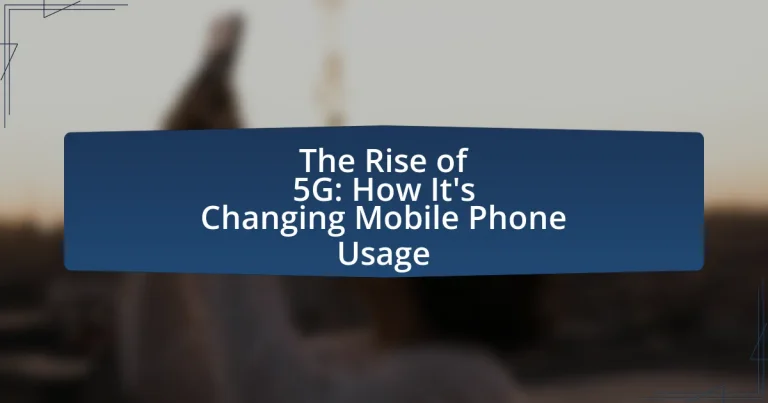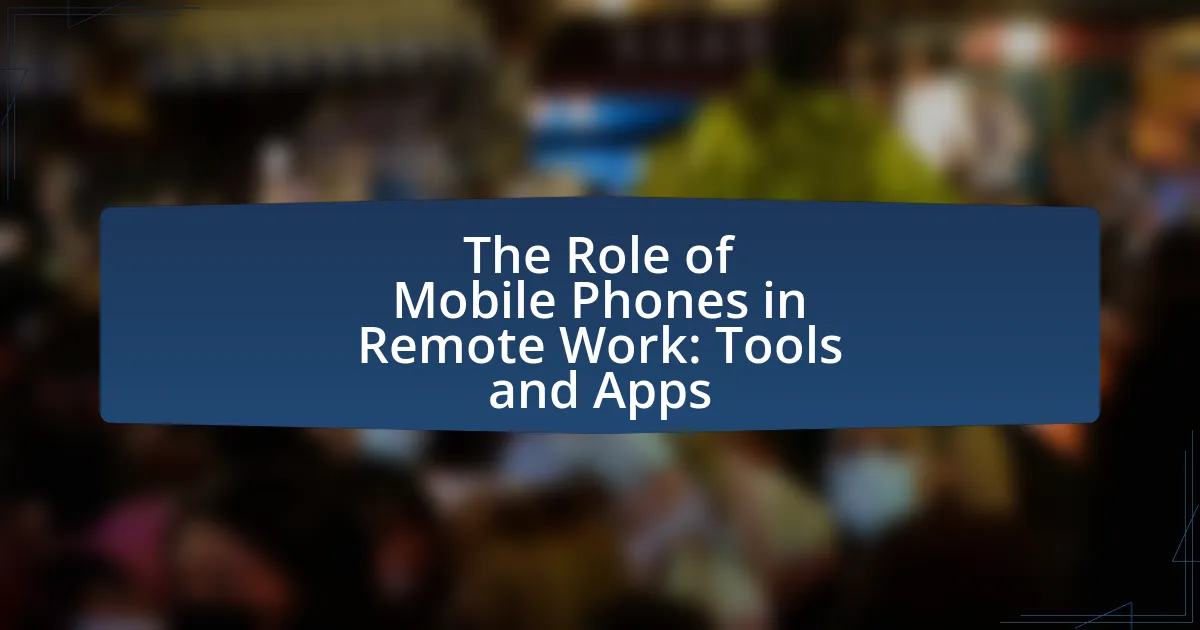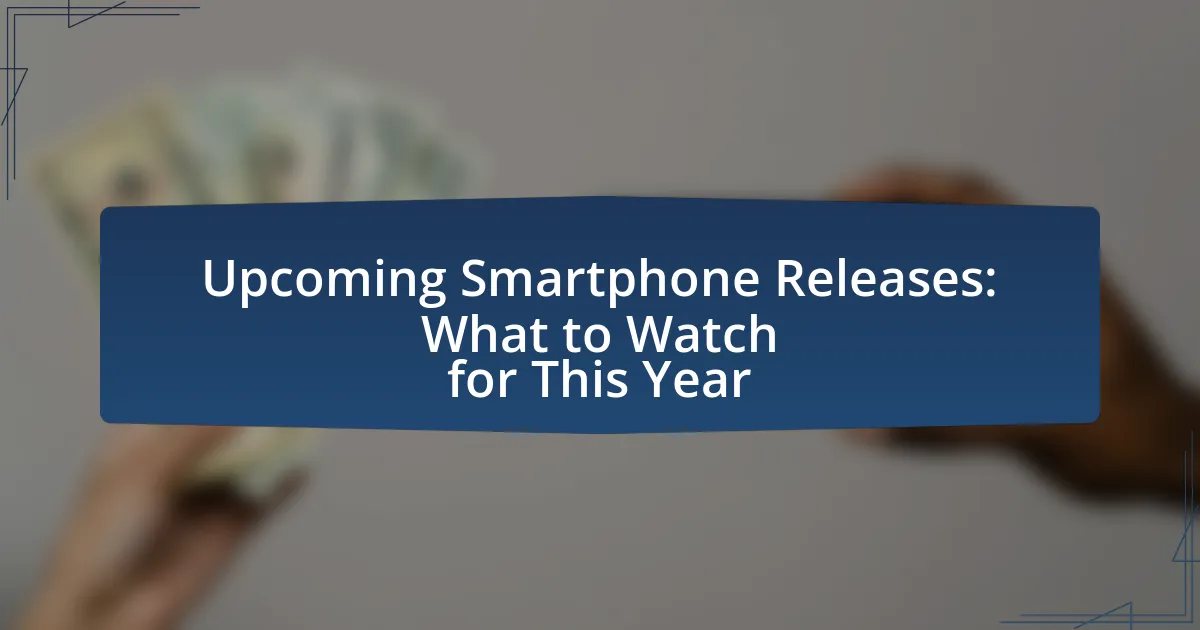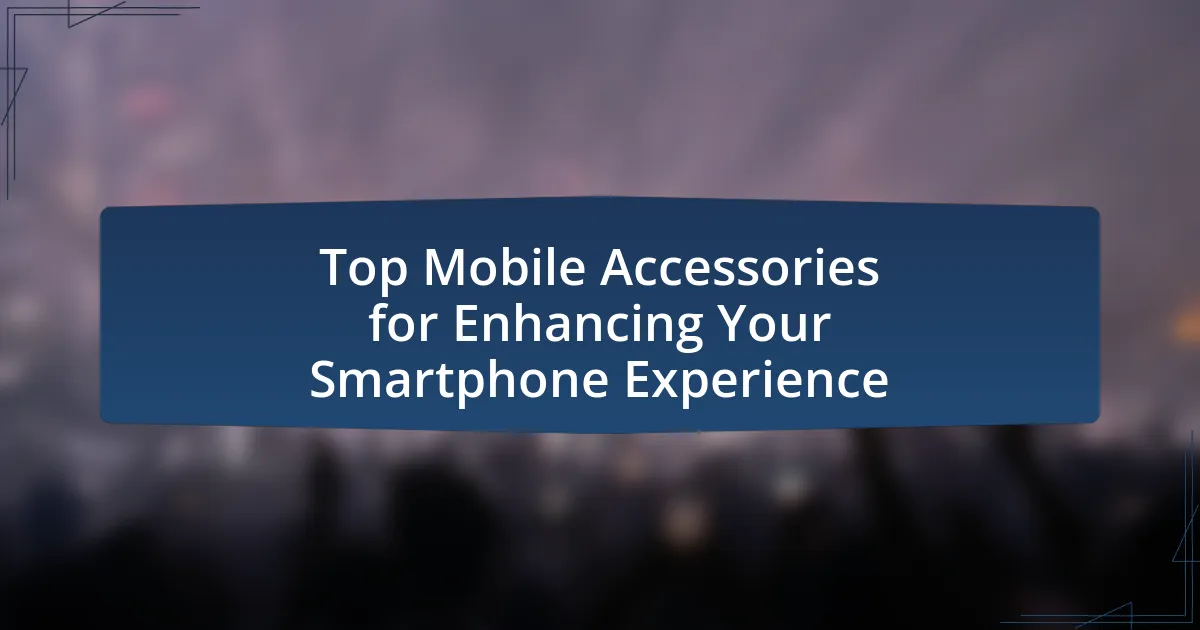5G, the fifth generation of mobile network technology, is revolutionizing mobile phone usage by delivering significantly faster data speeds, lower latency, and enhanced connectivity. With capabilities to achieve download speeds up to 10 Gbps and support for up to 1 million devices per square kilometer, 5G is enabling advancements in various sectors, including healthcare, transportation, and the Internet of Things (IoT). This article explores the technical advancements of 5G, its impact on user behavior and expectations, potential applications, and the challenges associated with its adoption, while also addressing economic implications and practical tips for users to optimize their 5G experience.
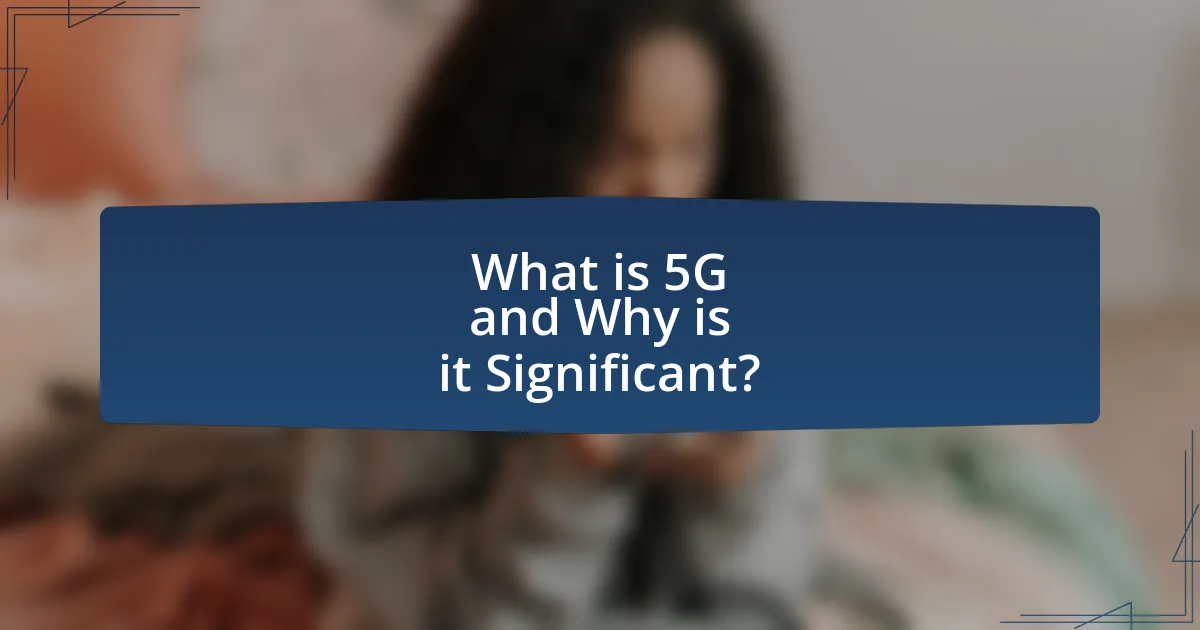
What is 5G and Why is it Significant?
5G is the fifth generation of mobile network technology, designed to provide faster data speeds, lower latency, and greater connectivity compared to its predecessors. Its significance lies in its ability to support a vast number of devices simultaneously, enabling advancements in areas such as the Internet of Things (IoT), autonomous vehicles, and enhanced mobile broadband experiences. For instance, 5G can achieve download speeds up to 10 Gbps, which is up to 100 times faster than 4G, facilitating real-time applications and services that require high bandwidth and low delay. This transformative capability is crucial for industries like healthcare, where remote surgeries and telemedicine can be performed with minimal lag, demonstrating the profound impact of 5G on mobile phone usage and beyond.
How does 5G technology differ from previous generations?
5G technology differs from previous generations primarily through its significantly higher data transfer speeds, lower latency, and increased capacity for connected devices. While 4G networks typically offer speeds up to 1 Gbps, 5G can reach speeds exceeding 10 Gbps, enabling faster downloads and smoother streaming. Additionally, 5G reduces latency to as low as 1 millisecond compared to 30-50 milliseconds in 4G, which enhances real-time applications like gaming and autonomous driving. Furthermore, 5G networks can support up to 1 million devices per square kilometer, vastly improving connectivity in densely populated areas. These advancements are supported by the deployment of new technologies such as millimeter waves and massive MIMO (Multiple Input Multiple Output), which enhance network performance and efficiency.
What are the key technical advancements in 5G?
The key technical advancements in 5G include enhanced mobile broadband, ultra-reliable low-latency communication, and massive machine-type communications. Enhanced mobile broadband significantly increases data rates, achieving speeds up to 10 Gbps, which is ten times faster than 4G. Ultra-reliable low-latency communication reduces latency to as low as 1 millisecond, enabling real-time applications such as remote surgery and autonomous vehicles. Massive machine-type communications support a vast number of connected devices, allowing up to 1 million devices per square kilometer, which is essential for the Internet of Things (IoT). These advancements collectively enhance user experience and enable new applications across various sectors.
How does 5G improve speed and connectivity?
5G improves speed and connectivity by utilizing higher frequency bands and advanced technologies such as Massive MIMO (Multiple Input Multiple Output) and beamforming. These enhancements allow 5G networks to achieve data transfer speeds up to 10 Gbps, significantly faster than 4G, which typically offers speeds around 100 Mbps. Additionally, 5G reduces latency to as low as 1 millisecond, enabling real-time communication and more reliable connections, especially in densely populated areas. This combination of increased bandwidth and reduced latency supports a greater number of simultaneous connections, facilitating the growth of IoT devices and applications that require high-speed internet access.
What are the potential applications of 5G?
The potential applications of 5G include enhanced mobile broadband, massive machine-type communications, and ultra-reliable low-latency communications. Enhanced mobile broadband allows for faster data speeds and improved connectivity, facilitating applications such as high-definition video streaming and augmented reality experiences. Massive machine-type communications enable the connection of a vast number of devices, supporting the Internet of Things (IoT) in smart cities and industrial automation. Ultra-reliable low-latency communications are crucial for applications requiring real-time feedback, such as remote surgery and autonomous vehicles. These applications are supported by 5G’s ability to provide higher bandwidth, lower latency, and greater capacity compared to previous generations of mobile technology.
How will 5G impact industries like healthcare and transportation?
5G will significantly enhance industries like healthcare and transportation by enabling faster data transmission, improved connectivity, and real-time communication. In healthcare, 5G facilitates telemedicine, remote surgeries, and real-time patient monitoring, which can lead to better patient outcomes and reduced costs. For instance, a study by the International Telecommunication Union indicates that 5G can reduce latency to as low as 1 millisecond, allowing for seamless remote surgical procedures. In transportation, 5G supports the development of smart vehicles and infrastructure, enhancing vehicle-to-everything (V2X) communication, which improves traffic management and safety. According to a report by McKinsey, the integration of 5G in transportation could reduce traffic accidents by up to 80% through real-time data sharing and analytics.
What role does 5G play in the development of smart cities?
5G plays a crucial role in the development of smart cities by enabling faster data transmission, lower latency, and increased connectivity for a wide range of devices. This advanced network technology supports the integration of Internet of Things (IoT) devices, which are essential for smart city applications such as traffic management, energy efficiency, and public safety. For instance, 5G can facilitate real-time data sharing between connected vehicles and infrastructure, enhancing traffic flow and reducing congestion. Additionally, according to a report by the Global System for Mobile Communications Association (GSMA), 5G is expected to connect over 1.5 billion IoT devices by 2025, underscoring its significance in creating efficient urban environments.
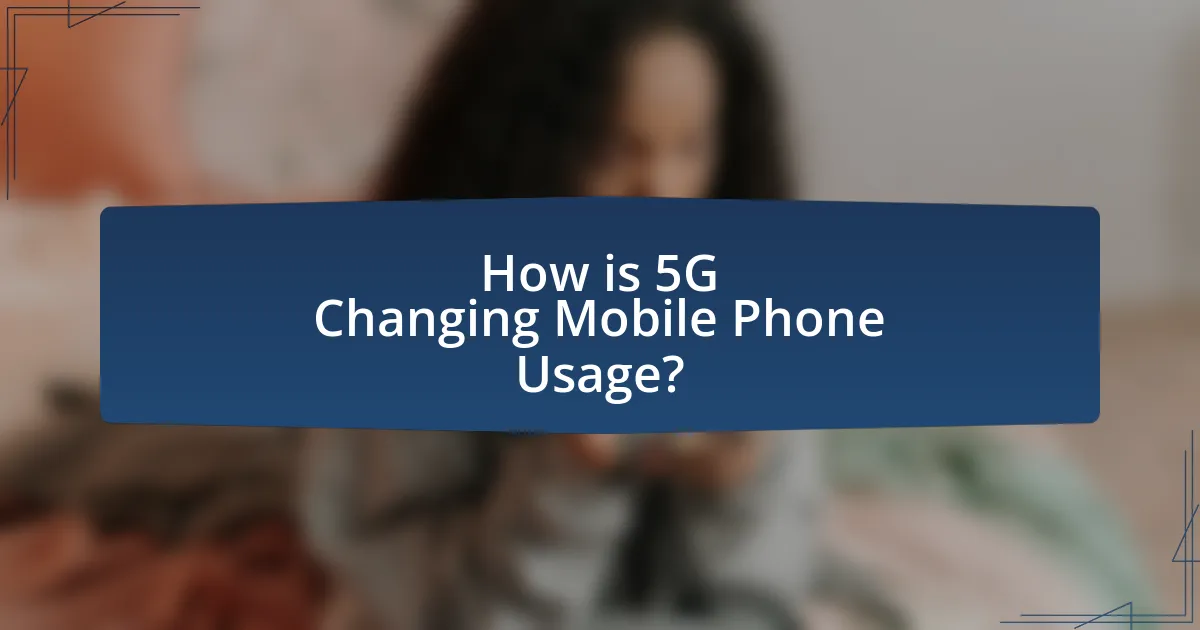
How is 5G Changing Mobile Phone Usage?
5G is changing mobile phone usage by significantly enhancing data speeds, reducing latency, and enabling new applications. With download speeds reaching up to 10 Gbps, users experience faster streaming, quicker downloads, and improved gaming experiences. The latency reduction to as low as 1 millisecond allows for real-time interactions, which is crucial for applications like augmented reality and remote surgery. Additionally, 5G supports a higher density of connected devices, facilitating the growth of the Internet of Things (IoT) and smart city technologies. This transformation is evidenced by a report from the GSMA, which predicts that 5G will account for 1.7 billion connections by 2025, illustrating its impact on mobile phone usage patterns.
What new features can users expect with 5G-enabled devices?
Users can expect significantly faster data speeds and lower latency with 5G-enabled devices. Specifically, 5G technology can deliver download speeds up to 10 Gbps, which is up to 100 times faster than 4G, allowing for seamless streaming of high-definition content and quicker downloads. Additionally, 5G reduces latency to as low as 1 millisecond, enhancing real-time applications such as online gaming and augmented reality experiences. These advancements are supported by the deployment of new infrastructure, including more dense networks of small cells and advanced antenna technologies, which collectively improve connectivity and user experience.
How does 5G enhance mobile gaming experiences?
5G enhances mobile gaming experiences by providing significantly lower latency, faster download speeds, and improved network reliability. With latency reduced to as low as 1 millisecond compared to 4G’s 30-50 milliseconds, gamers experience near-instantaneous response times, which is crucial for competitive gaming. Additionally, 5G offers download speeds that can reach up to 10 Gbps, allowing for quicker game downloads and updates, as well as smoother streaming of high-quality graphics. The increased capacity of 5G networks also supports more simultaneous connections, reducing lag during peak usage times. These advancements collectively create a more immersive and responsive gaming environment, aligning with the growing demand for high-performance mobile gaming.
What improvements can be seen in video streaming quality?
Improvements in video streaming quality include higher resolution, reduced buffering, and enhanced audio clarity. The advent of 5G technology significantly contributes to these enhancements by providing faster data transfer rates, which allow for streaming in 4K and even 8K resolutions without interruptions. According to a report by the GSMA, 5G networks can deliver speeds up to 10 Gbps, which is substantially higher than 4G, enabling seamless streaming experiences. Additionally, 5G’s lower latency, often below 10 milliseconds, minimizes delays, further improving the overall quality of video streaming.
How does 5G influence user behavior and expectations?
5G significantly influences user behavior and expectations by enabling faster data speeds, lower latency, and enhanced connectivity, which leads to increased demand for high-bandwidth applications. Users now expect seamless streaming, instant downloads, and real-time interactions, reshaping their engagement with mobile services. For instance, a study by Ericsson found that 5G users are more likely to engage in activities such as augmented reality and virtual reality, reflecting a shift in user preferences towards immersive experiences. This evolution in user behavior is driven by the capabilities of 5G technology, which supports advanced applications that were previously limited by slower networks.
What changes are observed in data consumption patterns?
Data consumption patterns have shifted significantly with the rise of 5G technology, leading to increased data usage and changes in user behavior. Users are now consuming more high-definition video content, with reports indicating that video streaming accounts for over 80% of mobile data traffic, a trend accelerated by 5G’s faster speeds and lower latency. Additionally, the adoption of data-intensive applications, such as augmented reality and virtual reality, has surged, as 5G enables seamless experiences that were previously hindered by slower networks. This shift is supported by a Cisco report predicting that global mobile data traffic will increase nearly threefold by 2023, highlighting the transformative impact of 5G on data consumption.
How does 5G affect the way users interact with apps and services?
5G significantly enhances the way users interact with apps and services by providing faster data speeds, lower latency, and improved connectivity. This technological advancement allows for real-time interactions, enabling applications such as augmented reality, virtual reality, and high-definition video streaming to function seamlessly. For instance, 5G networks can achieve speeds up to 10 Gbps, which is up to 100 times faster than 4G, allowing users to download large files in seconds and stream content without buffering. Additionally, the reduced latency of around 1 millisecond facilitates instantaneous responses in applications, enhancing user experience in gaming and remote collaboration tools. These improvements lead to more engaging and efficient interactions with mobile applications and services.
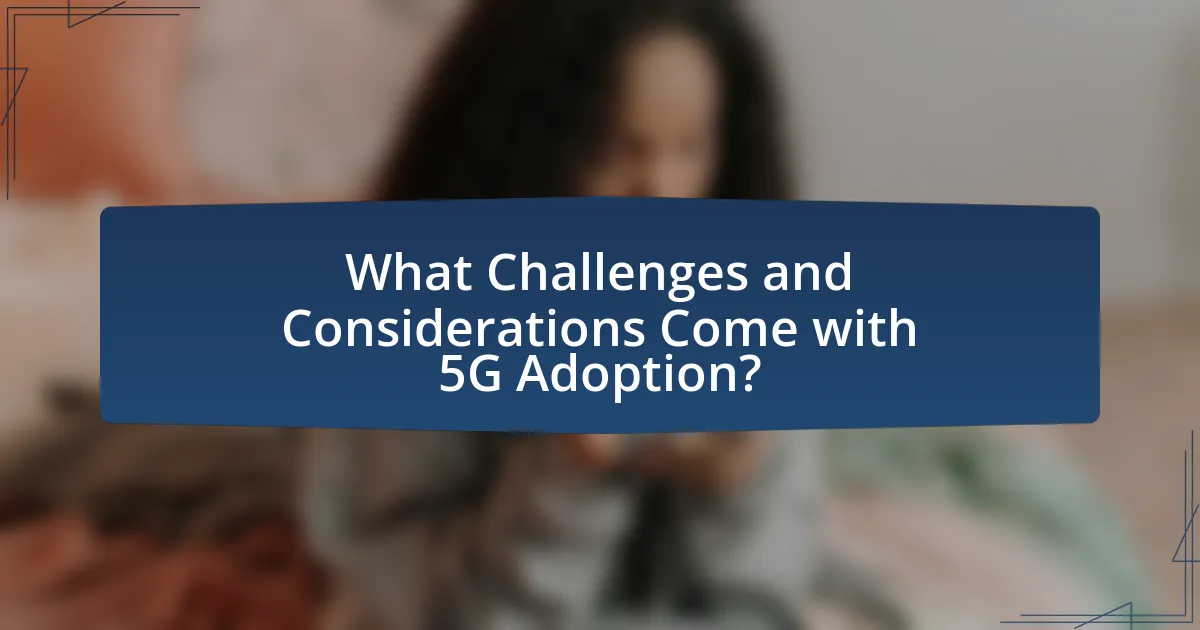
What Challenges and Considerations Come with 5G Adoption?
5G adoption faces several challenges and considerations, including infrastructure requirements, regulatory hurdles, and security concerns. The deployment of 5G networks necessitates significant investment in new infrastructure, such as small cell towers, which can be costly and time-consuming to install. Additionally, regulatory frameworks must adapt to accommodate the new technology, often leading to delays in rollout due to compliance with local laws and zoning regulations. Security is another critical consideration, as the increased connectivity and data transfer associated with 5G can expose networks to greater vulnerabilities, necessitating robust cybersecurity measures to protect sensitive information. These challenges highlight the complexities involved in transitioning to 5G technology.
What are the potential health and safety concerns associated with 5G?
The potential health and safety concerns associated with 5G include increased exposure to radiofrequency electromagnetic fields (RF-EMF), which some studies suggest may have adverse health effects. Research from the International Agency for Research on Cancer (IARC) classifies RF-EMF as possibly carcinogenic to humans based on limited evidence of an increased risk for glioma, a malignant type of brain cancer. Additionally, concerns have been raised about the impact of 5G technology on biological systems, including potential effects on cellular function and DNA integrity. The Federal Communications Commission (FCC) has established safety guidelines, but ongoing debates and studies continue to assess the long-term health implications of 5G exposure.
How are regulatory bodies addressing these concerns?
Regulatory bodies are addressing concerns related to the rise of 5G technology by implementing stringent safety standards and guidelines. For instance, the Federal Communications Commission (FCC) in the United States has established exposure limits for radiofrequency emissions to ensure public safety. Additionally, the International Telecommunication Union (ITU) is working on global standards to harmonize 5G deployment and mitigate potential health risks. These measures are supported by ongoing research and assessments, such as those conducted by the World Health Organization (WHO), which continuously evaluate the health implications of electromagnetic fields associated with 5G technology.
What measures can be taken to ensure safe 5G deployment?
To ensure safe 5G deployment, regulatory bodies must establish comprehensive safety standards and guidelines. These standards should include rigorous testing of 5G technology for health impacts, as evidenced by studies from organizations like the World Health Organization, which emphasize the need for ongoing research into electromagnetic field exposure. Additionally, public awareness campaigns can educate communities about 5G technology, addressing concerns and promoting transparency. Furthermore, collaboration between telecommunications companies and health experts can facilitate the development of best practices for infrastructure placement, minimizing exposure risks. Implementing these measures can help mitigate potential health risks associated with 5G deployment.
What are the economic implications of widespread 5G adoption?
Widespread 5G adoption has significant economic implications, including increased productivity, enhanced innovation, and the creation of new markets. The introduction of 5G technology is expected to boost global GDP by up to $13.2 trillion by 2035, according to a report by IHS Markit. This growth is driven by improved connectivity that enables advancements in various sectors such as healthcare, transportation, and manufacturing. Additionally, 5G facilitates the development of smart cities and the Internet of Things (IoT), which can lead to more efficient resource management and reduced operational costs. The economic impact is further evidenced by the projected creation of 22 million jobs globally related to 5G deployment and its applications.
How will 5G impact job creation and industry growth?
5G will significantly enhance job creation and industry growth by enabling new technologies and services that require skilled labor. The implementation of 5G networks is projected to create 3 million jobs in the United States alone by 2025, according to a report by the Economic Policy Institute. Industries such as healthcare, manufacturing, and transportation will experience growth due to increased efficiency and innovation driven by 5G capabilities, including faster data transfer and improved connectivity. For instance, the automotive industry is expected to benefit from advancements in autonomous vehicles, which rely on 5G for real-time data processing and communication. This technological evolution will not only create direct employment opportunities but also stimulate ancillary job growth in sectors supporting 5G infrastructure and applications.
What investments are necessary for 5G infrastructure development?
Significant investments in 5G infrastructure development include funding for network equipment, fiber optic cables, small cell installations, and spectrum acquisition. Network equipment, such as antennas and base stations, is essential for enabling high-speed connectivity, while fiber optic cables provide the necessary backbone for data transmission. Small cell installations are crucial for enhancing coverage and capacity in densely populated areas. Additionally, acquiring spectrum licenses is vital for operating 5G networks, as it allows operators to utilize specific frequency bands for communication. According to a report by the GSMA, global investment in 5G infrastructure is projected to reach $1 trillion by 2025, underscoring the scale of financial commitment required for comprehensive deployment.
What practical tips can users follow to maximize their 5G experience?
To maximize their 5G experience, users should ensure they have a compatible device and are in an area with strong 5G coverage. Using a 5G-capable smartphone allows users to access faster data speeds, while being in a location with robust 5G signals enhances connectivity. According to the Federal Communications Commission, 5G networks can provide speeds up to 100 times faster than 4G, significantly improving streaming, gaming, and downloading experiences. Additionally, users should regularly update their device software to benefit from performance enhancements and security improvements that optimize 5G functionality.
